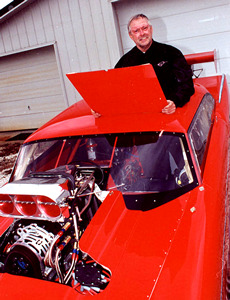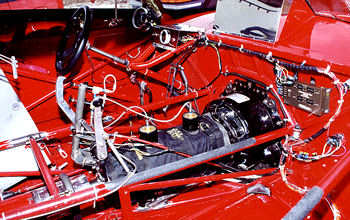 |
| Kuhlmann hammers the throttle and heats
up the Goodyear's at Las Vegas in December. Photo by Tim Marshall. |
After Bill Kuhlmann's horrendous crash and fire last year at Virginia
Motorsports Park it became obvious to everyone involved that how Nitro
Coupes were being built would have to be re-thought. Although Kuhlmann's
fire was by far the worst in the short history of the class, it was
far from the first. It was evident to everyone concerned that the rules
would have to be rewritten so that the drivers of Nitro Coupes would
have the protection the driver of a nitro-burning race car should have.
What better person to build the first of the "new age" Nitro Coupes
than Bill Kuhlmann himself? Thanks to Millennium Race Car owner Dave
Wood, Kuhlmann got that opportunity. Wood had purchased an unfinished
'57 Chevy Pro Mod car originally built in Canada and then worked on
in the race car factory of former Pro Mod World champ Tim McAmis. Wood
and his team had bought the '57 to run as a nitro coupe as a replacement
for their all steel '57 but, in order for it to be a legal Nitro Coupe
it was going to need to be changed over from a nitrous Pro Mod and upgraded
to 2001 Nitro Coupe specs. When Kuhlmann destroyed his own car Wood
graciously turned his '57 over to Bill, paid him to update it to 2001
nitro coupe specifications and then told him to take it to Las Vegas
for the Super Chevy race which was billed as the first race of the 2001
season.
DRO got the chance to take photos of the car as it was being built
which show some of the mandated safety improvements that will be incorporated
into the 2001 Nitro Coupes to protect the driver from being trapped
and to protect him from fire.
 One of the first changes mandated by Super Chevy Show rules and implemented
by Kuhlmann was installing a roof hatch and moving the head hoop of
the roll cage back so that the driver can stand up and exit the car.
His eyes still showed the effects of the fire when this photo was taken.
One of the first changes mandated by Super Chevy Show rules and implemented
by Kuhlmann was installing a roof hatch and moving the head hoop of
the roll cage back so that the driver can stand up and exit the car.
His eyes still showed the effects of the fire when this photo was taken.
 Another
change that Kuhlmann incorporated in the '57 was in thickness and material
he used in building the firewall and floor pans. In order to seal the
cockpit, Kuhlmann closed up as many holes in the firewall as possible
and rerouted wiring and plumbing so that it didn't go through the firewall
whenever possible. He used .032 thick aluminum for the firewall and
floor pans and didn't use any carbon fiber material to cut down the
spread of fire, smoke and fumes. Another
change that Kuhlmann incorporated in the '57 was in thickness and material
he used in building the firewall and floor pans. In order to seal the
cockpit, Kuhlmann closed up as many holes in the firewall as possible
and rerouted wiring and plumbing so that it didn't go through the firewall
whenever possible. He used .032 thick aluminum for the firewall and
floor pans and didn't use any carbon fiber material to cut down the
spread of fire, smoke and fumes.
|
|